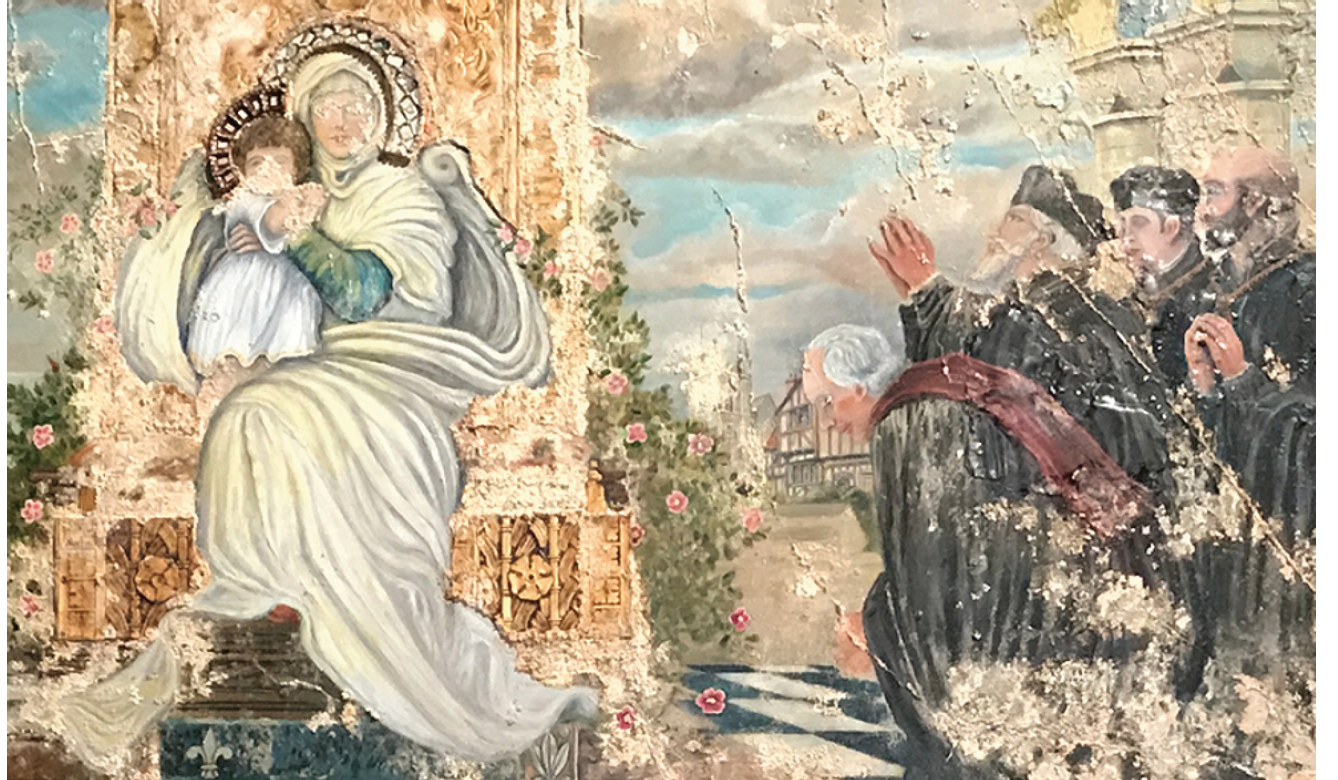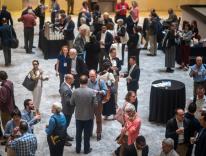One morning in 2019, after torrential rain, Bill O’Neill visited his parish church and was alarmed to see water cascading down the walls of one of the chapels.
Rainwater was pouring over the much-loved mural of Our Lady of Great Yarmouth, causing the paint to blister and peel. The painting was the pride and joy of parishioners at St. Mary’s, a church in the English seaside resort of Great Yarmouth in Norfolk. Now, virgin and child, saints, buildings, sky, sea, sailing ships—all were disappearing before Bill’s eyes. He alerted the parish priest and the chair of the church’s finance committee. As parishioners and priests gathered in the Lady Chapel, many of them were in tears.
Painted by Archibald Jarvis in 1921, the mural is a romantic portrayal of Mary and Jesus on a golden throne, venerated by saints, against the backdrop of the town and the sea. Visitors of all faiths and none would come to marvel at the painting and the church’s interior. At one time, St. Mary’s was extravagantly decorated throughout, and the mural was the best surviving example.
Surveys of the church, which was built in 1850, revealed that at some point, heavy concrete roof tiles replaced the original Welsh slates, which were much lighter. The extra weight put pressure on the roof timbers, causing them to bend and the valleys and gutters to fail. Rainwater had been seeping into the building for a long time, but the violent storm was like a dam bursting at a weak point above the Lady Chapel.
Not only was the mural ruined, but the whole building was at risk unless urgent—and very expensive—repairs were carried out, beginning with a new roof. These were well beyond the means of this poor parish. The town of Great Yarmouth is listed near the top of the British government’s indices of multiple deprivation; Catholics from more than fifty countries attend the church, many of them unemployed or with low-paying jobs in food-processing factories, hospitals, and hospitality. Flags representing their countries of origin grace the Sacred Heart Chapel. They include Nigeria’s—for the parish’s three priests who belong to a missionary congregation, the Sons of Mary Mother of Mercy—and Ukraine’s—representing newly arrived refugees.
But today, the splendid Gothic Revival church has a new roof, thanks to a major grant awarded by the government in the wake of the Covid pandemic. The money came from the Culture Recovery Fund, which provided grants for essential repairs to historic buildings in England from 2020 to 2022. Its purpose was to create jobs and to make up for the long period during the pandemic when places of worship lost most of their income and maintenance came to a halt.
In all, thirty-nine of the finest Catholic churches received grants totalling £6.6 million ($8 million)—an “unprecedented investment” according to Duncan Wilson, chief executive of Historic England, the public body that administered the grants.
The church in Great Yarmouth was awarded more than £450,000 ($550,000), which covered 80 percent of the cost of a new roof. The parishioners moved heaven and earth to raise the rest. They sought publicity in the media, introduced a “sponsor a slate” scheme—they got then prime minister Boris Johnson to sign one—and wrote to Pope Francis. The pope wrote back commending their efforts. More remains to be done, including the restoration of the mural of Our Lady. In the meantime, a parishioner has offered to pay for the image to be reproduced on a carved and painted screen to be placed in front of the mural. Plans are also afoot to refurbish the parish hall.

Suzi Pendlebury is the conservation architect at St. Mary’s, one of a small but influential network of Catholic professionals who are giving historic Catholic places of worship a new lease on life. At the heart of this network is the Patrimony Committee of the Bishops Conference of England and Wales, which collected and submitted applications for the post-Covid grants and then ensured the repairs met the tight deadlines set by the government.
Pendlebury, director of the architectural practice Thomas Ford & Partners, says the grants have led to a reconnection of parishes with their buildings: “Prior to this, many people assumed that ‘others’ would resolve repairs such as fixing the roof, but as soon as parishioners realized they could become engaged in the maintenance and care of the building, and seek funding for it, they started to be more aware of conservation-accredited architects—people who know how to look after the buildings. It was like turning a key.”
Another factor was government recognition of the role that many Catholic churches play in building social cohesion. Catholic migrants from around the world are finding a common home in their parishes, often located in the poorest towns and cities in Britain. At a parliamentary reception organised by the committee last April to celebrate the grants, the committee’s chair, Archbishop George Stack, said: “So often with the changing demographics in our country, when people make their home here, the first place they go to is the local Catholic church. It gives them a sense of identity and a sense of security.”
Archbishop Stack, the archbishop emeritus of Cardiff, singled out the case of St. Ignatius in Preston, Lancashire, built by the Jesuits in 1833. This grand Victorian Gothic church, the first in the town to include a spire, closed in 2014, and its future looked bleak. But the following year it was taken on by the Syro-Malabar Eparchy of Great Britain, a 40,000-member community founded in Kerala in South India. The eparchy is in full communion with Rome and follows the East Syrian liturgy, which dates back to the third century.
Renamed the Cathedral of St. Alphonsa, the Preston church was awarded almost £430,000 ($530,000) from the Culture Recovery Fund to replace timbers in the worst areas of dry rot and renew the roof. However, much more work remains to be done. Inside, Victorian stained glass and traditional English Gothic decoration combine with colorful Indian altar frontals. Statues of St. Alphonsa and St. Teresa of Calcutta stand alongside those of European saints. Huge crowds gathered at the cathedral to venerate the relics of St. Bernadette during a tour of Britain in 2022.
Another Catholic beneficiary of the post-Covid grants is Aylesford Priory in Kent, located in a picturesque spot by the River Medway and close to the Pilgrims’ Way, the ancient road from London to Canterbury. Aylesford includes a Syro-Malabar Mission dedicated to Our Lady of Mount Carmel.
The priory is a significant place in the history of the Carmelites. In 1242, the general chapter meeting determined that members should no longer be hermits but mendicant friars like the Franciscans and Dominicans. At that time, St. Simon Stock (died 1265) was superior general and lived at Aylesford. It was the order’s principal home until the Reformation, when religious houses were confiscated and dismantled. Aylesford was in private hands until 1949 when Carmelite prior Fr. Malachy Lynch (1899–1972) bought the site and presided over its transformation into a place of pilgrimage, commissioning beautiful art for a complex of new chapels and overseeing the return of St. Simon Stock’s relics, which were brought back to Aylesford from Bordeaux in 1951.
In recent years, the chapels have suffered water damage from leaking roofs. The number of Carmelite friars has dwindled, but Syro-Malabar clergy are helping reinvigorate Aylesford. Grants totalling almost £400,000 ($500,000) supported the re-roofing of the shrine complex.
The story of migrants breathing new life into the Catholic Church is not new. In the nineteenth and twentieth centuries, immigrants from Ireland fueled demand for Catholic churches and schools. Old Catholic families and wealthy converts helped pay for them, but so did the pennies of the poor.
I was reminded of this when I visited another St. Mary’s, this time in Newport, South Wales, built in 1840. Visiting is a little like stepping into one of those lovely Victorian railway stations, where super-slim cast-iron columns lend light and loftiness to the structure.
On the day I visited, I met with a retired head teacher who showed me around. She brought with her three parishioners in their sixties and seventies who had been altar servers since they were children. They told me they descended from Irish migrants brought to Wales as human ballast after ships had deposited their cargoes of coal. Families were left on mudflats outside the city, where they were met by priests who gave them shelter and the wherewithal to survive. Irish laborers built St. Mary’s Church, and some of their descendants are commemorated in a war memorial filled with Irish names and in a fine chapel dedicated to St. Patrick.
Today, migrants from the Philippines, India, and Africa have joined parishioners of Irish descent. Some of the newcomers were in the church on the morning of my visit, sweeping floors and polishing metalwork. St. Mary’s is in a poor area and there is a list of urgent repairs waiting to be done.
There are close to three thousand Catholic churches and chapels in England and Wales. Of these, more than 750 are listed as being of particular architectural and historic significance. The list is growing all the time thanks to the work of the patrimony committee in raising awareness of these hidden gems.
Sadly, the Culture Recovery Fund is now closed. But it has demonstrated what it is possible to achieve with a scheme dedicated specifically to places of worship. Unless and until it is replaced, a great many historic Catholic churches will continue to be at risk.
Please email comments to [email protected] and join the conversation on our Facebook page.
Previous Story
The Ecstatic
Next Story
Books in Brief


